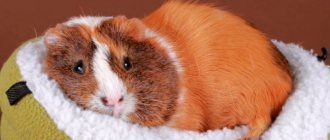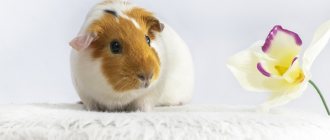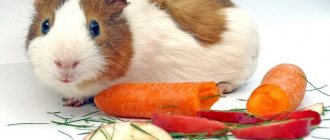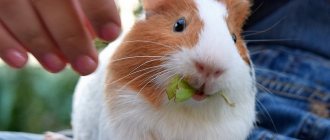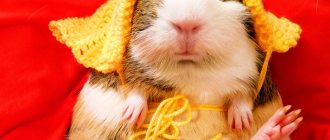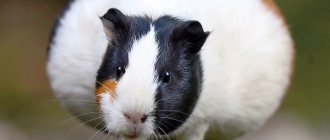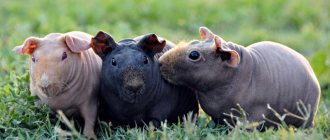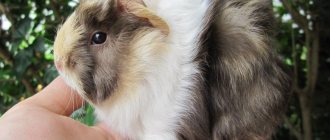- home
- Guinea pig
- Guinea pig health
02/18/2019 After purchasing a guinea pig, owners notice characteristic features of the pet’s behavior. The fluffy rodent loves affection and even a small child can handle it. Over time, strange details may appear in the animal's behavior. He begins to constantly jump and rush around the cage. What could cause such oddities?
Diseases
There are several reasons why your guinea pig will jump, jerk, or make other disturbing, erratic movements. Such reasons include the following:
- The appearance of skin itching when various parasites – lice eaters – appear on the animal’s fur. The animal often shakes itself in an attempt to get rid of them. To avoid this, it is necessary to constantly examine the appearance of your pet’s coat. You should examine your skin 1-2 times a week for peeling and redness. Their appearance is a sign of the onset of the disease. Over time, sores may form. If these symptoms occur, be sure to take the pig to a veterinary clinic or call a specialist at home. Only a qualified doctor can provide all the necessary assistance. He will prescribe the necessary medications to properly treat the rodent.
- Helminthiases are diseases caused by worms. The main signs of the disease are the appearance of inclusions in the animal's excrement and a sudden decrease in weight. To determine this, the owner must periodically check the animal’s feces for the presence of worms or their eggs.
- Diseases associated with the dental system. If the pig constantly jumps, shakes its head and also tries to chew through the bars, this indicates problems with its teeth. To help your pet avoid the formation of stones and plaque on the incisors, it should be shown to a veterinarian at the clinic. He will be able to tell you what the problem is and correct the abnormal growth of the roots of the teeth.
Expert opinion
Experts say that guinea pigs periodically eat their droppings to restore their intestinal microflora, just like other herbivores. This phenomenon is called coprophagy, it is considered completely normal and physiologically necessary for life, so there is no need to prohibit animals from doing this.
Zoologists claim that the microflora of the guinea pig’s cecum synthesizes substances necessary for the body:
- enzymes; B vitamins; amino acids; vitamins K.
At the first meal, these microelements are not absorbed in the body, so animals eat their feces and reabsorb the substances they contain.
Initially, rodents eat grass, hay and food, which contain a large amount of fiber, which does not have time to be digested immediately. As food particles pass through the gastrointestinal tract, they are influenced by bacteria, which break down food into amino acids. After the waste products have come out, the animal eats them, and all the substances are normally absorbed in the body for the second time. Thus, the pet's intestines will function normally.
Natural reaction
Sometimes the reason why your piggy is jumping can be due to its natural behavior. Most often this occurs in young individuals. The animals show their cheerful mood in this way, frolicking and rushing around the entire cage. Some rodents can rock the cage, making whistling sounds. If, in addition to the young pig, there are older individuals, then they begin to repeat after the young pig. The unusual behavior may last about 7-15 minutes, after which the pet either begins to drink and eat, or rests. This phenomenon among healthy pigs is called “popcorning.” The way they jump can be compared to the exploding kernels of corn when they are fried.
When to worry
Unfortunately, a pet's restless behavior is not always caused by positive reasons. There is a certain number of negative factors due to which a rodent behaves as if it were popcorning, these could be:
- blood-sucking insects;
- worms;
- dental problems.
Parasites
If an animal gets parasites, it begins to itch and chew its fur. This occurs because harmful organisms cause severe itching in different parts of the pig's body.
They can be divided into two main types:
- worms;
- skin insects.
If you identify one of these problems, you should definitely contact your veterinarian and take immediate action to combat them.
Helminthiasis
When a rodent is affected by this disease, not only itching and restless behavior are externally manifested. The animal is losing weight sharply, and dark spots are visible in its secretions. Therefore, when cleaning the cage, it is necessary to pay attention to the feces of the fluffy. If eggs or small bugs appear there, you should start taking special medications, but this should be done after consultation with a specialist.
Experienced breeders advise giving pets preventive medications that kittens are usually given, such as Dirofen, Prazicide, Stronghold.
Lice eaters, ticks and fleas
Blood-sucking parasites and lice eaters infect the rodent's fur coat. They cause very strong irritation throughout the animal's body.
Pig constantly:
- itches;
- bites himself;
- rubs against the bars of the cage;
- shakes.
Bald patches appear on the fur, redness and scratches are visible on the skin.
Harmful insects that attack the fur of guinea pigs:
- Ticks . There are fur, ear, tricacaria, sarcoptic and demodectic. It manifests itself according to all the signs listed above. It is strictly forbidden to treat your pet yourself; you must immediately contact a veterinarian, self-medication can lead to negative consequences.
- Fleas . Fluffies are affected by the feline representatives of this insect - Ctenocephalides felis. Their size does not exceed 5 mm, they can be transmitted through various carriers, including humans. These pests can be identified and removed by constantly brushing your pet with a special comb.
- Vlaseaters . These insects can cause a disease called trichodectosis, which leads to debilitation and death. Parasites stick to the hair of the fur coat, feeding on blood and the top layer of skin. They can be detected upon careful examination; these are small light-colored worms up to 3 mm long. They are also found by laying eggs, of which there can be more than a hundred. They are dealt with using special ointments or sprays based on permethrin. But before doing this, you should consult a specialist.
Dental diseases
If an animal constantly bites the bars of its cage, gnaws on a feeder or any other dense object, it means it has problems with its teeth . In their natural habitat, these rodents subject their incisors to constant stress, which wears them down. It is clear that at home they have no problems with chewing food, so the teeth grow to the point that they begin to interfere with your pet. But this may not be the only problem. It happens that a pig has bite problems at the genetic level, that is, inherited.
If such symptoms occur, the best solution for the furry owner would be to contact a veterinary clinic, where the cause of concern can be determined more accurately.
If your pet starts running around his home, there is nothing to worry about. The main thing for a beginner in caring for rodents is to determine why the animal suddenly started jumping and eating popcorn.
Return to the cage
If your guinea pig is jumping around the cage, this may be a reaction to the animal returning to it after a walk. Familiar smells and surroundings bring the animal into joyful excitement. This reaction is normal, so the owner should not worry. It happens that a pet constantly jumps off his hands, and the owner approves of this. Under no circumstances should you allow your pig to behave this way. If she actively jumps from the owner's hands into the cage and back, she may injure herself on the bars or injure her paws. Therefore, it is better to wean the animal from a bad habit.
The pet must be held tightly when inserted into the house, but not released. The pig will have to be held until it calms down. Then the rodent must be quietly placed on the floor. Do not put pressure on the animal's back to avoid damaging the spine. If the pig still breaks out of your hands, you will have to repeat your actions a couple of times.
Cons of guinea pigs: 7 fly in the ointment
There is nothing worse than disappointment from a pet. A responsible person will continue to care for the animal, but these responsibilities will not bring joy. When such an animal is gone, the owner will feel both shame and relief, but not sadness. An irresponsible person will simply get rid of an inconvenient pet, and it’s good if he finds good hands for it and does not throw it in the trash.
Before getting a guinea pig, you need to learn about the characteristics of these animals, which not everyone will like:
They make a lot of noise
Guinea pigs not only constantly chew on something, they love to dig into the litter and run around the cage. And they are capable of making a huge number of sounds. Pigs whistle shrilly, squeak, squeal, grumble, chirp, and grind their teeth.
Owners find begging to be a particularly annoying habit. As soon as you slam the refrigerator door or walk past the cage, the pig starts screaming, demanding attention or a treat.
If there are several pets, then they will talk to each other out loud, whistling about something of their own. Talkativeness is the main difference between pigs and other rodents and rabbits.
They litter and get dirty
Guinea pigs love to dig around the bedding, scattering sawdust, hay, food and their own poop around the cage. Daily housekeeping will be required to keep the room clean. In addition to cleaning around the cage, you need to regularly change the filler.
It is impossible to train a guinea pig to a litter box; it eats and poops constantly. Therefore, when you release an animal for a walk, expect to find traces of its activity everywhere.
They are afraid of people, but cannot stand loneliness
At the genetic level, the pig suspects that everyone wants to eat it. Despite the fact that these animals are not aggressive, you should not expect friendliness, trust and a desire to communicate from them either. You will have to spend time accustoming the pig to your hands. A pet can be wary of people for a long time, hiding in the house every time they try to pick it up.
However, under no circumstances should you leave the pig alone. They literally waste away and die of boredom. Ideally, you need communication with relatives. That is, in order for the pig to be happy, you must purchase two or more same-sex animals and paw them less, watching the idyll from afar.
May cause allergies
If one of your family members is allergic to cats or other animals or prone to asthma, you cannot hope that they will not be allergic to a rodent. You can check the reaction to an allergen in guinea pigs in the laboratory, or even more reliably - talk to friends or a breeder for some time with the animals.
Not only the pigs themselves can irritate the respiratory tract, but also dust from sawdust and hay, which must be present in the cage 24 hours a day.
Expensive veterinary care
These rodents have fragile health and are difficult to treat. Infectious diseases in almost 100% of cases end in death, a draft threatens pneumonia, open sunlight - heat stroke. Most often, pigs get sick from improper feeding: forbidden food causes bloating, diarrhea, and poisoning.
An ordinary veterinarian is unlikely to be able to help: the body of guinea pigs is fundamentally different from that of cats and dogs. Find out in advance whether there is a rodent specialist in your city - a rodentologist (ratologist). If not, contact experienced guinea pig breeders.
Seeing a rodentologist is an expensive pleasure. The most common reason for contacting such a specialist is the pathological growth of teeth in mumps (not only the incisors, but also the chewing teeth located deep in the mouth). If teeth are not properly ground down, they are filed under general anesthesia.
Primitive behavior
A guinea pig cannot be trained like a dog. You shouldn't expect too much from them at all. The most sociable rodents can respond to their name, but teaching them commands is a hopeless idea. They also do not take any active part in games, preferring to simply run around the room and chew everything they can get their teeth on.
Coprophagia
Like rabbits, pigs eat their own droppings. Not those solid cylinders that they leave on the litter, but the “primary” liquid, underdigested feces. The pig catches it directly from the anus, curling up into a ball.
For pigs this is absolutely normal and necessary, that’s what Mother Nature came up with. But some people find this feature off-putting.
Other reasons
In some cases, a furry rodent twitches and jumps for completely different reasons. To determine them, the owner should remember events related to the pet that could please him. The animal can rejoice at the received treat or fresh tasty grass. If he has recently been walked outdoors, this may also cause unusual behavior.
It may have to do with the conditions in which the animal is kept. A rodent cannot warm up if it is in a cramped room. He needs more space to play. Due to the lack of active movements, the pet lies on its side and twitches. To change the situation, a caring owner must increase the space by adding toys, wheels and tunnels.
conclusions
Guinea pigs jump because of joyful events or because of health problems. To determine the cause, it is necessary to monitor the behavior and condition of the pet. If you purchase a rodent from other people, you should find out whether the animal has been trained. Then the owner will not be concerned about the pet’s strange behavior.
Guinea pigs are rightfully considered one of the most unpretentious pets.
They ideal for keeping them at home: they are small in size, they don’t eat that much, they don’t run around the house and they can be placed in a small cage.
And their care is practically minimal. Guinea pigs are very friendly, they rarely bite, which means they are not dangerous even for the smallest members of the family. Pigs are very gentle and affectionate, calm, the main thing for them is delicious food and a clean home.
Although sometimes strange things happen to the cutest creatures in the world. Suddenly the pigs may start jumping and running around the cage, making a lot of noise. If you have recently brought such an animal into your home, then you will immediately wonder why such metamorphoses suddenly begin to occur with a calm animal.
Some owners panic, thinking that their four-legged friend has gone crazy, while others, on the contrary, rejoice, claiming that if their pets are active, then they are healthy.
What actually happens to guinea pigs and should you worry when they start jumping and running around the cage very actively, creating noise that is so unusual for them?
In reality, everything is not as scary as it seems. When your guinea pig starts running and jumping around the cage, this should not bother you, he is happy about something and there is nothing wrong with that, in this way the rodent shows others that he is happy.
Necessary for care
Like any other pet, a guinea pig requires a wide variety of grooming accessories. These include:
- cage or aquarium;
- feeder;
- sippy cup;
- house;
- filler;
- mineral stone;
- toys;
- carrying;
- hygiene products;
- brush-comb and nail clipper.
Cage or aquarium
Keeping a guinea pig is allowed both in an aquarium and in a cage. The main condition is size: the dwelling must be at least 50 cm in length and 30 cm in height so that the animal can move comfortably. If you have decided on a cage, then it is best to take a closer look at the options that have a plastic bottom. Plastic is quite easy to care for, it is easy to wash, dry, etc. A wooden base is not suitable due to the fact that these animals drink a lot of liquid per day, and therefore excrete a large amount of urine. The wood will simply become unusable in a very short time. You can purchase an aquarium in the above sizes. It, like a cage with a plastic bottom, is easy to wash and clean. But you should be careful, since glass is a very fragile material and when moving it, for example, to another room, you should follow safety rules (the pet should not be in the aquarium, it should be transferred to a carrier).
cell
Feeder
The feeder should be heavy enough so that the guinea pig cannot knock it over. An excellent option would be bowls made of ceramics, stainless steel, etc. It is also recommended to buy 2-3 containers. For example, one will be used for vegetables or fruits, and the second for dry food.
Sippy cup
A vertical ball sippy cup is perfect for a guinea pig. It is usually made of plastic with a metal tip. In such a drinking bowl there is no need to change the water daily, but this is done about 2-3 times a week.
House
Be sure to install a small house in the cage or aquarium. Your pet will sleep in it, relax, or simply retire when he wants to be alone. Most often, such houses are made of wood with a round “door” cut out in the middle. The most optimal size is 25 cm in length and 15 cm in height. This space is enough for the animal to hide and at the same time feel comfortable.
house
Filler
When arranging the cage, do not forget about the bedding. It will create comfort in the cage, prevent the animal from freezing and, to some extent, maintain cleanliness. You can use sawdust or ground corn cobs as a filler. Under no circumstances put cotton wool, newspaper, paper, etc. in the cage as bedding, as this is not safe for your pet’s health.
Mineral stone
To maintain dental health and calcium levels in your guinea pig's body, mineral stone is essential. After all, it serves not only as a vitamin complex, but also perfectly helps the animal grind its teeth. This stone is sold in a pet store, and its price is quite affordable.
stone
Toys
Guinea pigs are somewhat similar in behavior to decorative rabbits. They love to play. Therefore, be sure to buy some interesting and funny toy for your pet, for example, a tunnel, a hammock, a mirror, a rolling wheel, etc. The game will not only bring joy and pleasure to the animal, but will also strengthen muscles, and will also be an excellent preventive measure against obesity.
Carrying
If your plans did not include traveling together or any trips with your guinea pig, then you will still need a carrier. Transporting an animal in your arms, in a box or blanket is strictly prohibited. For example, you need to visit a veterinarian or transport the animal to another house or apartment; in such life situations, a carrier will definitely help you out. The pig will feel safe and the transportation process will go smoothly.
Hygiene products
Guinea pigs are considered clean animals, but sometimes they are still allowed to be bathed. For such cases, it is necessary to use special hygiene products that can be purchased at a pet store. The most popular of them:
- "Biogance" - bio-perfume;
- "Veda" - wheat shampoo.
Brush-comb and nail clipper
Caring for your guinea pig's coat and claws is extremely important. To do this, you need to purchase a special comb with soft bristles (combing is done daily), as well as a nail clipper for trimming the claws (the procedure is performed as they lengthen).
Diseases
Sometimes endoparasites or lice eaters can get on an animal's fur. They cause itchy skin. Therefore, the guinea pig itches and jumps, and also makes other restless, chaotic movements. In addition, the animal often shakes itself.
It is important to regularly check the condition of your pet's coat, especially for long-haired breeds. You need to examine your skin at least once a week. The onset of the disease may be accompanied by redness and peeling. Later wounds appear. If such symptoms are detected, you should consult a specialist. Help can be provided by a veterinarian who will select the necessary medications and prescribe the necessary treatment.
Contacting a veterinarian
However, sometimes an animal’s unusual behavior can also mean health problems. If the pet jumps around the cage, lies around, itches itself on everything, and the fur looks dull, begins to fall out and bald patches appear - this indicates the appearance of skin parasites. An animal can become infected with them not only by walking down the street. Often flea or tick larvae get to the animal along with low-quality hay or bedding, as well as poorly washed food. If your pig shows anxiety and loses his appetite, you should consult a doctor. Analysis of the skin scraping will determine both the type of parasite and the degree of infection.
Basic moments
Crazy jumps around the cage are not a cause for concern, but a reason for joy. The galloping animal is not sick, but happy and splashes out its accumulated energy.
Popcorning is crazy jumps and somersaults
Strange actions performed by a pet are called popcorning. The choice of name was due to the amazing similarity of rodents to corn kernels bouncing in the microwave while popcorn is being made.
Funny behavior is common to all ages, but is more common in young individuals.
Pig shows last about 5 minutes and include:
- jumping and turning over in the air;
- dancing using the fifth point;
- squeals, squeaks and other crazy sounds of delight;
- falls and febrile convulsions;
- cutting circles at the incredible speed of a racing car.
If the pig runs around like crazy and successfully involves other cage inhabitants in its madness, then release the animals to freedom. After expanding the territory, the rodents will quickly calm down and fall into deep sleep, replenishing the energy expended.
After a burst of energy comes a sound sleep
Natural reaction
In most cases, the answer to the question “why is a pig jumping” is that this is normal behavior for piglets. As a rule, young animals are prone to such actions. They become happy, they run around the cage and make noise. They can even rock the cage. Some pigs whistle at this.
If there are several individuals in the cage, then representatives of the older generation can also join in the fun of the piglet. After this warm-up, which can last 5-10 minutes, the pigs rest, eat and drink water.
And he behaves strangely...
Owners who have recently acquired new “tenants” are often bothered by the squeaking of their charges in a variety of situations.
Problems with stool and urination
Does he squeak when he goes to the toilet? Often such a sound is accompanied by the need to cope with natural needs - both small and large needs.
In this case, you first need to simply observe the further behavior of the animal. If a slight inflammation occurs, then simply ensure your pet is clean and warm in the cage. However, a squeak can be a signal of disorders both in the genitourinary system and in the gastrointestinal tract. In this case, it is necessary to urgently take the animal to the local Aibolit.
And suddenly it bites!
Pets can squeak when they are angry. It was already noted above that squeaking can mean dissatisfaction or protest.
The same applies to bites. Most often, they can be “rewarded” by an animal that is unwell, and against its will (he doesn’t realize that for purely humane reasons!) they take it in their arms - how can you not be indignant!
Listen to the sound. https://xvostus.com/wp-content/uploads/2018/02/zvuki-morskih-svinok-svinka-vozmuschena.mp3
And good luck, and the treatment procedures will begin. Here both teeth and voice will come into play.
The same applies to pregnant females, who are annoyed by any attempt to invade their personal space.
Are your teeth itching?
Gnawing on the bars is not dangerous. Owners often notice that the guinea pig seems to be gnawing on the bars of the cage. And the question naturally arises: maybe this is how she grinds her teeth down?
In such cases, experts reassure: the rodent clamps the rod in a completely different area from where the teeth are. Simply the chewing movements made make this sound quite loud. It may also be accompanied by a squeak.
Sociable pigs locked in a cage suffer greatly from loneliness and gnaw at the cage “out of grief”; this is rather a type of pig psychosis, which, however, is easily curable. All you need is:
- place the pet in a larger cage,
- give the opportunity to actively move in a special pen or even on the floor,
- place a friend in the home, remembering that the animals must be same-sex (to avoid unplanned reproduction),
- provide food in sufficient quantity.
Active running and jumping
Squeaks and runs? Most often, this is how complete satisfaction with life is expressed. This behavior is especially typical for young individuals. They cheerfully rush around the cage squealing and hooting, infecting older pigs with their delight.
At the same time, noise, fuss, squeaking, and whistling are heard. This does not last all the time, so there is no cause for alarm.
However, it may happen that the movements of the animals are too active and restless; running alternates with jumping and is also accompanied by squeaking; pigs itch periodically.
Carefully examine your pet's fur and skin, paying special attention to dandruff, bald spots, sores, and hair loss. If such signs are present, we can assume the presence of a fungus, subcutaneous mite or lice-eater. Does your pig squeak often?
Does your pig squeak often?
Yes, all the time! No, rarely.
The reason is parasites
Pig scabies
The scabies mite, which settles in the deep layers of the skin, causes the skin to itch unbearably.
The guinea pig begins to itch so intensely that this leads to hair loss - the animal literally goes bald - and the formation of wounds and ulcers at the site of the lesion.
This poses a double danger: pathogens of more serious diseases can penetrate through such a wound.
How does scabies mite infection occur? It may be brought into a cage with poorly washed food in the form of hay or grass. The larvae of the parasite can be transmitted by both infected animals and people, for whom it is, in principle, not dangerous. The scabies mite leads to hair loss, sores and pustules form.
Places of insect parasitism are most often noted on:
To determine the presence of a tick, a deep skin scraping is done. If the result is positive, the veterinarian will determine the method of treatment. This course can be quite long - up to a month.
As a rule, it consists of three “approaches” of 10 days each in the form of subcutaneous injections of Ivermectin. This is explained by the fact that the injections are not able to destroy the eggs laid by females and are “forced to wait” for the appearance of new offspring.
The administration of Otodectin, Novomek, and Ivermec is also practiced. The drugs can be used to treat infected areas two to three times a day. Moreover, animals that were in contact with a sick individual also need to be treated.
In addition, the most thorough sanitary treatment of the cell with lime sulphide, an aqueous solution of which is prepared at a rate of 1:40, is also necessary. Before returning a sick animal to the living space, the cage is wiped dry.
Similar treatment should be carried out in case of infection with other parasites.
Why does a guinea pig sneeze?
Who eats hairs?
Skin parasites called lice eaters are similar to regular lice. Their size - almost one and a half millimeters - allows you to see the insect on the skin, especially with a magnifying glass.
This type of parasite eats blood, skin particles and hair follicles of the animal. Due to the fact that they gnaw the hair at the base, baldness begins on the diseased back. So the first symptoms of lice-eater infestation are as follows: Lice-eaters are similar to ordinary lice.
- hair loss;
- severe itching (and not always);
- Dandruff is often observed.
A pig can become infected with the “help” of hay, sawdust, or loosely packaged food purchased at a pet store, where there could be decorative pets infected with lice.
Parasites infect the back, croup and perineum of a pet.
Treatment is carried out, as a rule, with sprays intended for treating cats and rodents for the same purpose: Acaromectin, Bars-, Bolfo-, Celandine-spray. Some breeders recommend using “human” drugs for head lice. Stronghold or Advocate drops for kittens are considered effective, with a dosage strictly in accordance with the weight of the pet.
By the way, many experts do not recommend using sprays to treat affected areas, since the animal, while washing, can lick them off and become poisoned. It is better to use drops, applying them topically - especially on the affected areas.
Pediculosis in a pet
Most often, lice settle on the head and ears. Severe itching is a common symptom when infected with lice. In addition, peeling of the skin and redness of its areas are observed. The guinea pig squeaks, jumps around the cage and itches.
Often, lice appear at the same time as a tick, transmitted through contact with an infected animal or through contaminated bedding.
These parasites are visible to the naked eye. They choose the head and ears of a rodent as their habitat.
Treatment is also carried out by administering Ivermectin. If the infestation has not yet started, then lice can be dealt with by carefully combing the fur with a thick comb.
Why are you jumping here, flea?
The most common parasites in pigs are fleas. Their bites also cause:
- itching;
- skin lesions;
- partial baldness.
Anemia may occur with multiple bites!
If treatment is not treated promptly, the “attack” of parasites deprives the pet of appetite and sleep, it is in a state of constant stress, which can lead to exhaustion and even death.
To remove these parasites from pets, medications containing pyrethrin are used.
Worms
If, in addition to the fact that the pig is constantly itching, she also loses her appetite, but her thirst increases, and apathy is observed, we can assume that she has worms.
If this problem is not identified in time and not dealt with, the animal will begin to wither before our eyes, serious digestive problems will arise, which can result in intestinal obstruction.
For every type of rodent, anthelmintic drugs such as “Shustrik”, Dirofen pastes or Prazicide suspensions are produced.
Nutrition
In order for your pet to feel good and not get sick, you should feed it properly. Guinea pigs are unpretentious eaters. They need to be given food in the morning and evening. The pet's diet mainly consists of dry food:
- hay;
- clover, dandelions, plantain, nettle;
- straw;
- cereals (millet, flax seeds, oats and sunflower seeds);
- cherry, currant, raspberry, gooseberry, pear and apple leaves;
- birch, maple, oak bark and their leaves;
- legumes (beans, lentils, peas).
You can use food purchased at pet stores. Just don’t change them often to avoid developing gastrointestinal upset. The cage should also contain mineral salt wheels and chalk so that the guinea pig receives all the substances necessary for growth and a full life.
Wet food should be included in the diet in minimal quantities - approximately 7 grams per kilogram of the pig's weight. These foods include carrots, apples, pears, beets, bell peppers, lettuce, zucchini, cabbage, pumpkin, and turnips. In the summer, you can pamper your pet with carrot and beet tops, corn leaves, and pea branches.
It is forbidden to feed your guinea pig potatoes, various cereals, cottage cheese, watermelon, sweets, and salty foods. It is also prohibited to give winter cucumbers, plums, spinach, eggs, fish, meat, green onions, radishes, mushrooms and bread. Before treating your pet with herbs and vegetables, they must be thoroughly washed and dried.
Since these rodents love to drink, you need to make sure that the water in the sippy cup is always fresh. It needs to be changed every day. For such purposes, only purified or filtered water is suitable. You should absolutely not use tap or boiled water.
Return to the cage
Another option when a guinea pig jumps is to return the animal back to the cage. The rodent enjoys familiar surroundings and smells; this is also a natural reaction of the pig and there is no need to worry in this case.
Sometimes it happens that a guinea pig jumps out of the owner's arms, and the owner allows and even encourages this behavior of the animal.
Remember! Your pet may fall and injure its paws if it actively jumps from your hands. Therefore, he should be weaned from such behavior in the future.
To do this, holding the animal tightly, you need to stick your hands inside the home and hold them a few centimeters from the floor. The pig needs to be held until it calms down. Then carefully place the pet on the floor, but do not let go until the rodent gives up its attempts to escape from you. You need to hold it carefully so as not to damage the back. This lesson may need to be repeated several times.
What to do if your guinea pig gives birth
A day after giving birth, you need to briefly remove the female from the cage and inspect the litter. If dead or non-viable cubs are found, they are removed from the cage. In this case, you need to be careful and not touch living and healthy individuals. Before and after the procedure, you must wash your hands with laundry soap. Complete cleaning of the cage is carried out only three days after the birth.
If the male lived in the same cage with the female, after the birth of the offspring he is moved to another place. Living together can provoke re-fertilization, which will ultimately negatively affect the health of the female. This will increase the likelihood of the death of the first offspring. In addition, it is not uncommon for adult males to kill newborns. Therefore, the mother remains alone in the cage with her brood.
There are cases of postpartum shock in the female, when she does not care for the cubs, but tries to move as far away as possible. In this case, she needs to be briefly separated from the offspring and calmed down with affection or special treats. In the absence of the mother, a heating pad is placed in the cage to prevent the pigs from freezing. It usually doesn't take long for the female to calm down.
As a rule, a nursing mother has enough milk for her entire litter. Otherwise, milk or cream is added to her diet. This will help the body replenish its supply of nutrients.
Sometimes the appearance of weak and non-viable cubs occurs. This happens for the following reasons:
- Malposition.
- Large litter - the more individuals in the litter, the smaller and weaker each of them will turn out.
- Early birth, premature animals have poor fur and soft claws.
Weak piglets are characterized by small size and lethargy (cannot roll over or raise their head). Females do not care for such cubs. You can try to feed such animals yourself, but they have little chance of survival.
conclusions
Why do guinea pigs jump? Often this happens because they are happy with everything and simply enjoy life. This is mainly typical for young people, but older pigs can also run and jump, although not very high. In some cases, the owners themselves teach the animals various tricks, including jumping and running in circles. Perhaps you got an already trained pet.
Did you like the article? Share with friends: [supsystic-social-sharing >
- Related Posts
- What to feed your guinea pig
- Guinea pig's hair is falling out
- Diagnosis, symptoms and treatment of worms in guinea pigs
Features of manifestation
Popcorning in guinea pigs manifests itself differently in each animal, but there are common features. A rodent can:
- Jump high;
- turn over during a jump, doing a somersault;
- actively wave its paws;
- it is unusual to twist the fifth point;
- rush in a circle at high speed;
- try to overcome invisible obstacles;
- make loud, unusual noises (squeaking, squealing, or muttering);
- fall to the floor of the cage as if in a fit;
- quickly jerk your head;
- convulse.
The duration of the attack is about 6 minutes, but more protracted cases also occur.
When pig farmers see this picture for the first time, they may panic. Owners have thoughts about their pet's insanity or nervous system disorder.
We can safely say that there is no need to worry, this is the norm for a rodent.
Not enough vitamins?
Don't forget to feed your pet with vitamins. The animal itches, has a rash on its skin, and hair falls out. The pet is apathetic and inactive. Sometimes he gets constipated.
If a concerned owner takes a sick pet to the veterinarian, and the tests done do not confirm the presence of any parasites, a diagnosis can be made: vitamin deficiency. Most often it manifests itself in the winter-spring off-season and is associated with a lack of succulent feed containing vitamin C.
What to do in this case? Treatment is extremely simple: you need to increase the portions of such feed. You can also add ascorbic acid to drinking water - no more than 1 mg per liter of liquid.
Experts highly recommend placing a bunch of fresh parsley in the cage, rich in this vitamin and loved by guinea pigs.
It is also necessary to provide the sick rodent with a quiet and warm place so that the weakened body does not catch a cold, which can lead to pneumonia.
Nutrition composition
A very important component of a healthy life for a guinea pig is nutrition. This animal is forbidden to starve, not because the body needs nutrients, but because these animals lack peristalsis
This feature is that processed food can leave the intestines only if new food arrives, in other words, a new piece of food pushes through the already processed one.
But you should be very attentive and careful, you cannot leave them hungry, but it is also prohibited to overfeed them, because this can lead to obesity, which is also dangerous for the animal.
Therefore, you need to approach the organization of your diet as responsibly as possible, adhering to the daily nutrition standards:
- 60% is feed.
- 20% - vegetables and fruits.
- 20% - hay, branches of fruit trees, crackers.
We must not forget about vitamins and minerals. The animal must always have clean water.
How does it manifest?
Popcorn attacks can cause fear and panic in an inexperienced owner. At these moments the animals:
- quickly run in circles;
- jump and twitch while jumping;
- they squeak and squeal loudly;
- periodically fall;
- shaking and turning their heads.
The process lasts 5–7 minutes, but there are also protracted cases. There is no need to be afraid of such scenes. This is not a sign of rabies or mental problems, but a natural manifestation of increased excitability of the animal. In such cases, the pig is released from the cage so that it splashes out energy and does not get injured in a cramped space. After the “fun” the animal calms down and falls asleep. Young individuals are susceptible to attacks more often than adults.
What can it be confused with?
The pet's body movements during popcorning can be confused with the manifestation of fear, which was caused by:
- Loud noise;
- sudden movements;
- sudden touch by the owner;
- cleaning the cage (some animals don’t like this).
Popcorning is a relatively safe process that stops on its own and does not subsequently affect the pet’s behavior. And frightened, chaotic movements require immediate elimination of the cause that caused them, because at this moment the animal is experiencing severe stress.
In addition to fear, your pet's jumping can be caused by:
- Blood-sucking parasites - ticks, fleas. The animal will itch and its fur will fall out. Infection usually occurs through hay.
- Worms. Signs of this disease are a decrease in the pet’s weight, the presence of parasites or their eggs in the feces.
- Dental disease. If your pig is desperately trying to chew through the bars of the cage and is constantly running around, this may indicate a dental problem.
The energetic jumping and squeaking caused by popcorning is a normal manifestation of your pet's joy and high spirits. To rule out the possibility of illness, you should monitor your mumps during an attack. If there are no dangerous symptoms, then there is no reason to worry.
Sometimes guinea pigs can surprise even experienced breeders, let alone beginners who are stunned, trying to figure out why their pet is twitching and shaking its head. When seeing such a sight for the first time, pig owners are horrified and begin to suspect various terrible diseases. What could be the reasons for their instant activity?
Origin
Skinny is a relatively new breed. Naturally, animals with such data cannot live in the wild. In 1978, within the walls of the Armand Frapper Institute, in Montreal, Canada, the fact of a new mutation of a hairless pig, which appeared naturally, was officially recorded and described. This is where the history of the breed could have ended if the phenomenon had not repeated itself in 1984. The bald white pig gave scientists the idea of breeding radically hairless pigs.
As a result, the first female was given the nickname Skinny. Later this nickname grew into the official name of the breed. Translated as skin and bones.
The first hairless animals bred were used exclusively for dermatological research. Their immune system is similar to humans.
Scientists worked hard on the breed, increasing the animal's endurance. To strengthen immunity at the genetic level, she was crossed with selfies. As a result, the animals left the walls of the laboratory and ended up in the homes of guinea pig lovers with a fairly strong immune system. However, even today, Canadian breeders recommend updating the skinny's blood every two generations to maintain the animal's immune system.
Negative signals
A frightened guinea pig will say a dull “Urrrr”, similar to a vibrating alert on a phone, and will tremble slightly. But she indicates irritation with a short sharp squeal - for example, when you carelessly touched her. If the pig is angry, it squeals for a longer time, while clicking its teeth, as if warning: “I’m not in the mood for jokes!”
One of the most impressive sounds a pig makes can be heard at night. This is a very sharp intermittent squeak, similar to the cry of a bird caught in a snare. At the same time, the pig freezes in place, her gaze glazes over. An inexperienced owner may be afraid for his pet. This sound is used by pigs to call their relatives. Little pig babies can express their fear this way.
Since guinea pigs are herd animals, they find it sad to live alone. If your pig makes this noise frequently, try petting your pig more often or give him a buddy in his cage.
If the pig is hungry, you won't miss it. She will stand up and scream shrilly throughout the apartment: “Wee-wee-wee!”, moving her ears. It’s amazing how loud such a small animal can be! Guinea pigs study their owners. They usually remember sounds, such as the sound of a knife hitting a cutting board when preparing a salad or the rustle of a bag from which cabbage is taken out. Subsequently, upon hearing these sounds, the pigs whistle invitingly. They also have a well-developed sense of smell. So you’re unlikely to be able to quietly snack on a cucumber; the alarm will immediately go off!
Popcorning in guinea pigs is a condition of an animal in which its behavior is, at first glance, inappropriate: chaotic running, jumping, convulsions. This looks unusual, but should not cause panic. This playful state is natural and safe. However, its signs are similar to those of some diseases, so it is important to correctly interpret your pet’s behavior.
What the sounds of guinea pigs tell us
From the first minutes of the appearance of a guinea pig, your house will be filled with a variety of sounds: whistling, squealing, grumbling, grunting and other sounds that this cute animal makes. All this is an expression of satisfaction, fear, aggression, or a warning to comrades about impending danger.
The sounds you hear from your guinea pig express his mood at the moment. Over time, you will learn to understand your pet well. We will talk about the basic sounds and their interpretation:
The most common sound a guinea pig makes is a sharp whistle, which is repeated at intervals of about a second. This is a signal to greet the owner when the pig is hungry and it is time to feed. The sound is similar to "whip, whip." These same sounds may indicate that your baby is demanding attention.
If your pet whistles softly and squeals gently, it means he is satisfied!
Grunting and sniffing another individual indicates a friendly greeting.
Grunting and rattling, similar to drumming, indicate a greeting to other individuals, and the male thus attracts the attention of the female, and indicates readiness for the mating ritual. It's like he's saying "brrr." A higher, shorter "brrr" means the guinea pig is irritated or frightened by the loud noise.
For example, she can react to a nearby phone ringing or the sound of a TV, loud or unfamiliar voices around
A higher, shorter "brrr" means your guinea pig is irritated or startled by a loud noise. For example, she can react to a nearby phone ringing or the sound of a TV, loud or unfamiliar voices around.
A high-pitched and loud piercing squeak, similar to a groan, stopping only with inspiration, means that the guinea pig is in pain.
Tapping and clicking teeth indicate that the pig is angry and ready to attack (this happens mainly if two males meet). This sound also indicates that the guinea pig is afraid of another individual or person.
These animals are not only talkative, but also active. You can tell a lot about the state of the animal by their behavior and body movements.
If individuals touch their noses, this means that they are sniffing and greeting each other. Stretching out on the floor signifies comfort and tranquility. Jumping up indicates your pet is in a good mood and is playful. Throwing its head up indicates that the animal is demonstrating strength. If a guinea pig begins to purr and lowers its head, this means that the animal is scared and offers to make peace. The guinea pig's tapping its teeth and creaking indicate aggression, thus it warns its opponent that jokes are bad. Stretching your head forward indicates vigilance. If a guinea pig has its paws tucked in or pressed against a wall, it means that it is helpless and requires protection. The female opens her mouth wide and shows her teeth - thus driving away the annoying male
To distract the enemy's attention, the guinea pig has to freeze in place and pretend to be dead.
The guinea pig is a unique creature. It will never cease to amaze you if you want to know more about this animal. Finally, let’s talk about interesting facts related to guinea pigs:
- It’s impossible to believe looking at this small rodent, but the ancestors of guinea pigs are huge creatures that weighed up to 700 kg.
- Guinea pigs are most active at night. The animal sleeps only about 10 minutes, and they sleep several times a day.
- Don't be alarmed if your guinea pig starts eating its own droppings. With these actions, it compensates for the lack of vitamins B and K in the body. When passing through the intestines again, these vitamins are better absorbed.
- Guinea pigs have the opposite number of chromosomes to humans. A person has 46 of them, and a guinea pig has 64.
- Under unfavorable or stressful conditions, a pregnant female guinea pig can “preserve” the pregnancy for several years or “absorb” the embryos.
- The longest fur of guinea pigs reaches 50 cm. This is a feature of Peruvian rodents.
- Penicillin is deadly to guinea pigs.
- A fall even from a low height can end disastrously for an animal, and can even be fatal.
- In the wild, guinea pigs live in burrows in small groups. Animals communicate with each other using special signals, which we talked about.
- When they appeared in Europe, the animals cost a lot of money and only the nobility could afford such a pet. In England, guinea pigs lived at court and were the favorites of Queen Elizabeth I.
